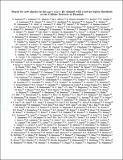Por favor, use este identificador para citar o enlazar a este item:
http://hdl.handle.net/10261/22150COMPARTIR / EXPORTAR:
 SHARE SHARE
 CORE
BASE CORE
BASE
|
|
| Visualizar otros formatos: MARC | Dublin Core | RDF | ORE | MODS | METS | DIDL | DATACITE | |

| Título: | Search for new physics in the mu mu+e/mu + is not an element of T channel with a low-pT lepton threshold at the Collider Detector at Fermilab |
Autor: | CDF Collaboration; Cabrera, Susana CSIC ORCID; Cuenca Almenar, Cristóbal CSIC; Álvarez González, B.; Casal, Bruno CSIC; Cuevas, Javier CSIC ORCID; Gómez, Gervasio CSIC ORCID ; Rodrigo, Teresa CSIC ORCID ; Ruiz Jimeno, Alberto CSIC ORCID ; Scodellaro, Luca CSIC ORCID ; Vila, Iván CSIC ORCID; Vilar Cortabitarte, R. CSIC ORCID; Aaltonen, T. | Fecha de publicación: | 18-mar-2009 | Editor: | American Physical Society | Citación: | Physical Review - Section D - Particles and Fields 79 (5): 052004 (2009) | Resumen: | A search for new physics using three-lepton (trilepton) data collected with the CDF II detector and corresponding to an integrated luminosity of 976 pb(-1) is presented. The standard model predicts a low rate of trilepton events, which makes some supersymmetric processes, such as chargino-neutralino production, measurable in this channel. The mu mu + l signature is investigated, where l is an electron or a muon, with the additional requirement of large missing transverse energy. In this analysis, the lepton transverse momenta with respect to the beam direction (p(T)) are as low as 5 GeV/c, a selection that improves the sensitivity to particles that are light as well as to ones that result in leptonically decaying tau leptons. At the same time, this low-p(T) selection presents additional challenges due to the non-negligible heavy-quark background at low lepton momenta. This background is measured with an innovative technique using experimental data. Several dimuon and trilepton control regions are investigated, and good agreement between experimental results and standard-model predictions is observed. In the signal region, we observe one three-muon event and expect 0.4 +/- 0.1 mu mu + l events from standard-model processes. | Versión del editor: | http://dx.doi.org/ 10.1103/PhysRevD.79.052004 | URI: | http://hdl.handle.net/10261/22150 | DOI: | 10.1103/PhysRevD.79.052004 | ISSN: | 1550-7998 |
| Aparece en las colecciones: | (IFIC) Artículos |
Ficheros en este ítem:
| Fichero | Descripción | Tamaño | Formato | |
|---|---|---|---|---|
| collider detector.pdf | 409,58 kB | Adobe PDF |  Visualizar/Abrir |
CORE Recommender
SCOPUSTM
Citations
17
checked on 18-abr-2024
WEB OF SCIENCETM
Citations
9
checked on 29-feb-2024
Page view(s)
309
checked on 19-abr-2024
Download(s)
210
checked on 19-abr-2024
Google ScholarTM
Check
Altmetric
Altmetric
NOTA: Los ítems de Digital.CSIC están protegidos por copyright, con todos los derechos reservados, a menos que se indique lo contrario.
